
The Netherlands was neutral in the First World War. Belgium, Luxembourg
and Switzerland were neutral by treaty but the Netherlands was neutral
by choice. Although the Dutch was not one of the belligerents it was
one of the first to mobilise and sent around 200,000 troop to defend
the Nineteenth century Waterline (
Waterlinie) and Amsterdam Fortifications (
Stelling van Amsterdam).
The Dutch managed to maintain its neutrality but had to cope with the
consequences of the war: refugees, food shortages and the need to
intern soldiers or sailors - from both sides - who happened to end up
in Dutch territory.
After the war, the Dutch gave the deposed Kaiser Wilhelm II refuge. He lived out his days at Doorn House (
Huis Doorn)
until his death in June 1941 in German occupied Netherlands. This was
not the first time the Dutch had helped Britain’s enemies. In
1900, the cruiser (
pantserdekschip)
Hr.Ms.Gelderland,
was sent - with British agreement - to take Paul Kruger, President of
Transvaal, one of two Boer states at war with Britain, to exile in the
Netherlands. He was received by Queen Wilhelmina, and stayed in the
country until a couple of months before his death in July 1904. Several
streets in the Netherlands are still named after Kruger or othe Boer associations. Almost forty
years after Kruger’s arrival, the Queen who gave him refuge would seek
her own safety, in Britain, and was taken there by the destroyer HMS
Hereward.
After the Great War many Austrian and Hungarian children were fostered by Dutch
families and some settled in the Netherlands. After Hitler came to power, a
new influx of refugees came to the Netherlands from Germany, mainly
Jews, including the family of Anne Frank.
By the late 1930s, the Dutch state was understandably nervous about the
international situation. It desperately wanted to maintain its
neutrality and forbade any joint planning with the Allies to
prepare for its defence lest this provide an excuse for an invasion.
The seizure in November 1939 of two British agents five metres from the German border at
Venlo led to the head of Dutch military intelligence
losing his position. The so-called "Venlo incident" was used by the German Nazi
government to link Britain to Georg Elser's failed assassination
attempt on Adolf Hitler and help justify Germany's invasion of the
Netherlands.
In the run up to war, The Netherlands’s rearmament programme came too late. The greatest
deficiency was the complete lack of tanks. The country hoped that
its neutrality would be respected and that if an invasion occurred its
defences based on static fortifications and flooding, would hold out
until the Allies came to their assistance. None of these hopes were
justified.
The Whitsun invasion
In the early hours of Friday 10 May 1940, Germany launched
Fall Gelb
(Operation Yellow), its attack on western Europe, through the
Netherlands and Belgium. There were four main thrusts to the attack on
the Dutch. The first involved landings by paratroopers in the
west of the country. One of the main objectives was the capture of
airfields near The Hague that could, then be used to bring in troops by
plane, so-called airlanding troops. Other paratroopers were tasked with
capturing the Royal Family and leading members of the government.
Further south, paratroopers sought to capture airfields and strategic bridges in and around Rotterdam, including an audacious
coup de main involving seaplanes which landed on the New Maas river (
Nieuwe Maas) in the centre of the city and captured a major bridge.
These airborne units were to hold their positions until the arrival of
the main infantry and armoured units. These attacked along three axes.
One went through the south of the country and then swung north to
approach Rotterdam, relieving the paratroopers who had
secured the strategic bridges. The idea was to unlock the so-called
“Fortress Holland” (
Vesting Holland), a stronghold that also included The Hague and Amsterdam.
The other German advances were through the middle of the country, to
Utrecht and to the North. The latter was halted at the eastern end of
the
Afsluitdijk, the barrier that separated the Wadden Sea from the Zuiderzee. Had the Germans succeeded in taking both ends of the
Afsluitdijk, they could have threatened Amsterdam from the north.
The German paratroop and air landings around The Hague met with mixed
success. Some of the follow-up transport planes had to land on beaches,
motorways or fields, rendering most of them useless for collecting
reinforcements from Germany. Others had to land on airfields that were
unsafe, and planes were damaged as they landed. Some paratroopers were
dropped in the wrong place but the presence of so many airborne troops
in the lightly defended western flank caused the Dutch lots of
problems, even if the German objectives were not always secured.
Actions around Rotterdam were far more successful and arguably, of
greater strategic value, especially after the failure to capture the
heads of government or the Royal Family. They were evacuated to
Britain, for the most part with British assistance, leaving General
Henri Winkelman, Commander-in-Chief of Land and Naval Forces, as the
senior representative of the Dutch state in the country.
The Dutch put up stiffer resistance than expected but the Germans were
advancing on almost every objective. The Dutch air force was
non-existent, and following the bombing of Rotterdam on the 14 May, to
avoid further attacks on population centres,
General Winkelman decided the armed forces in the Netherlands would
“capitulate” - not surrender. The distinction was important, the
government did not surrender and armed forces abroad would continue the
struggle.
After five days of fighting, the Germans were able to take over the
Dutch mainland and adjoining islands. The invasion gave German forces
room to attack Belgium from the north whilst simultaneously acting as
bait to attract the Allies to advance north, a point of contention
between the British and French. Securing the Netherlands also gave
Germany access to air and naval bases closer to Britain from where
attacks could be launched.
The Royal Navy in the Netherlands, May 1940
No plans were made with the Allies to prepare for a German
invasion in order to protect Dutch neutrality. Unilateral plans were
made. For example, the Dutch Navy planned to relocate ships to Britain,
and British naval officers carried out surreptitious reconnaissance
missions to Dutch ports with a view to possible demolition work.
When the invasion took place, all Britain could do was retrieve what it
could from a bad situation. France sent troops into the southwest of
the country, the province of Zeeland, and attempted to relieve
Dordrecht, an important German objective south of Rotterdam.
British action concentrated upon evacuating people. These included
refugees fleeing the Germans (especially Jewish civilians, both German
and Dutch), diplomats and officials from various nations, Dutch
ministers and officials and the Dutch Royal Family. The Sadler’s Well
Ballet on tour in the country and including Dame Margot Fontaine, was evacuated. So were 1,300 German
troops captured by the Dutch, including a regimental commander, at that time the
most senior German in British hands.
Other actions related to the recovery of assets. As well as industrial
diamonds, the gold reserves in Amsterdam were successfully
shipped out but gold reserves in Rotterdam were not recovered, and an
attempt to retrieve securities and bonds from the Bank of the
Netherlands in Amsterdam also failed.
Finally, small British forces landed at the ports of IJmuiden,
Flushing, the Hook of Holland and Rotterdam. They were tasked with
destroying anything of value to the enemy, principally oil stocks and
port installations. A composite battalion of Irish and Welsh Guards
landed at the Hook to provide support for the evacuation of the British
diplomatic mission in the Hague, British expatriates and the Dutch
government.
Despite its other wartime commitments, including the evacuation of
troops from Norway, more than sixty British vessels were sent to the
Netherlands during the five day invasion. They ranged from
requisitioned ferries acting as troopships, through to trawlers acting
as minesweepers, MTBs (Motor Torpedo Boats), destroyers and a few light
cruisers.
This motley collection of ships found themselves in the major ports and
harbours of Den Helder, IJmuiden (at the mouth of the Amsterdam ship
canal, the Noordzeekanaal), Scheveningen (The Hague), Hook of Holland,
Rotterdam and Flushing, carrying out one or more of the rescue and
recovery tasks. The MTBs actually sailed up the
Noordzeekanaal into the
IJsselmeer and ended up being among the final units to leave for
Britain.
The backbone of the Royal Navy’s commitment to the Netherlands was the
destroyer force. Given how stretched the Navy was, to put together such
a large force was no mean feat. The destroyers were close at hand, the
Nore Command at Harwich and Dover Command. Some 23 V&W destroyers took part in
Operations off the Dutch, Belgian and French Coast (ADM 199/667) in May 1940. They were twenty years old and out of
date, their powerful 4.7-inch guns comparable with some light cruisers
were no defence against attack from the air. They often had to depend
upon the seamanship of the captain, or luck, to survive an air attack
unscathed. Yet, with their high speed were ideally suited for the high
tempo shuttle actions of those early May days.
HMS
Walpole had a simple task,
to transfer three individuals from Harwich to IJmuiden on the night of
Sunday 12th May to Monday 13th May (which would have been the Whitsun
Bank Holiday) and bring them back on Monday evening. IJmuiden was, and
still is, a fishing, ferry and steel port at the mouth of Amsterdam’s
ship canal, the
Noordzeekanaal.
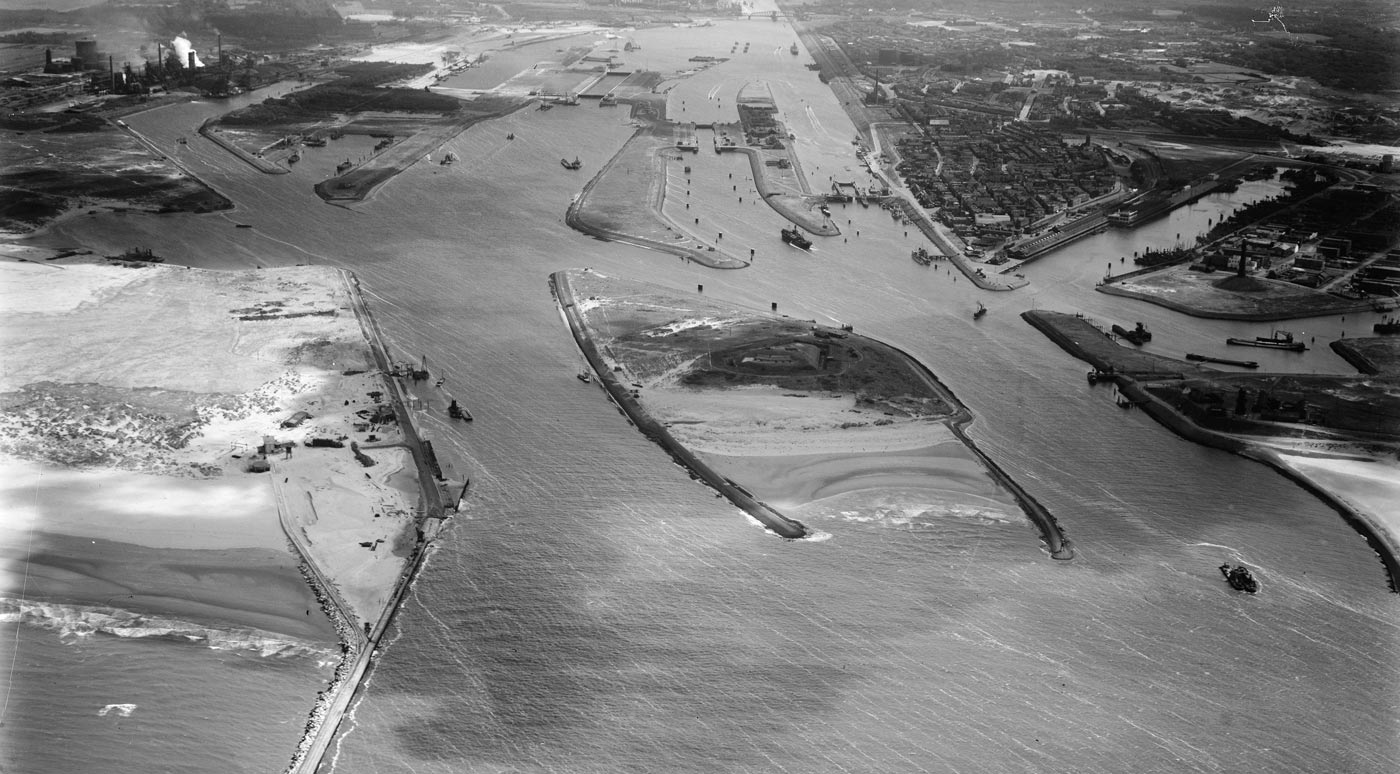 Aerial view inland from IJmuiden on the Noordzeekanaal to Amsterdam
Aerial view inland from IJmuiden on the Noordzeekanaal to Amsterdam
The Netherlands Institute of Military History Collection
In 1940, the Diamond Trading Company in London was the centre of the
global diamond trade, with Amsterdam and Antwerp the centres of cutting
and finishing for both jewelry and industrial diamonds. Small in size,
the inherent value of industrial diamonds was vastly outweighed by what
they could bring to the war effort of whoever possessed them.
Industrial diamonds have the necessary physical characteristics to be
effective in the manufacturing processes of a range of objects. These
include aeroplane engines and related machinery, artillery, gyroscopes,
tanks and torpedoes, prisms and lenses for gun and bombsights.
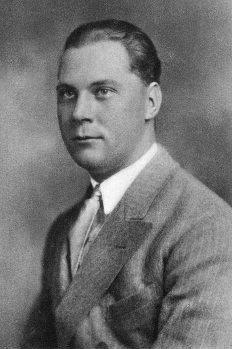
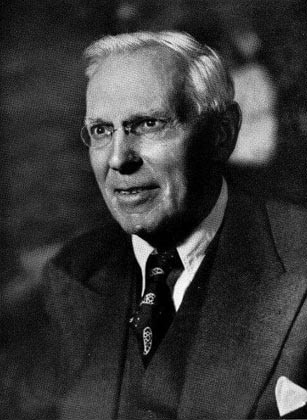
The three passengers on HMS
Walpolewere
tasked with recovering as many industrial diamonds from Amsterdam
as they could. Two of the party were employees of J.K. Smit en Zonen,
at that time one of the largest diamond companies in the world. The other was a
member of the British secret service. J.K. Smit en Zonen was an
international company with an office in London. Two of its Dutch
representatives in Britain, Jan Kors Smit and Willem Woltman, joined
HMS
Walpole.
Jan Kors Smit (on left) was the grandson of the company’s founder, Jan
Kors, and son of the current head, Mr. Johan J. Smit (on right) in
Amsterdam. Both photographs are courtesy of JK Smit Diamond Tools.
The third member of the group was Lt. Col. Montagu Reaney Chidson, a
much-storied man. He was originally an officer in the Royal Garrison
Artillery, but was one of the earliest military pilots, gaining his
wings before the First World War. Come 1940, Chidson was part of
Section D of MI6, the template for the Special Operations Executive,
SOE. Chidson’s military and intelligence connections with the
Netherlands dated back to the First World War and immediate post-war
period. In the late 1930s he returned to the country as Passport
Control Officer in The Hague. This was the cover post for the local
head of MI6, the Secret Intelligence Service (SIS). His successor was
one of the two SIS officers kidnapped in the German intelligence coup at the Dutch border town of Venlo in November 1939.
The improvised and secret nature of the diamonds operation means that there is
virtually nothing written down in official (British) documents. HMS
Walpole received no written orders, there are no ship’s logs to refer to and, apparently, no after action report from
Walpole. HMS
Walpole
and its passengers are absent from the reports of Dutch naval and
military officers in IJmuiden during the German invasion and from
Commander Goodenough’s report on Operation XD(A), to destroy fuel reserves at Amsterdam and block the harbour at IJmuiden.
The frustration is all the greater because the vessels involved in
other sensitive missions to IJmuiden, such as the evacuation of Crown
Princess Juliana and her family, are mentioned. Further, the ship and
army officer tasked with recovering bonds and securities from the Bank
of the Netherlands (
De Nederlandsche Bank) are also mentioned in these military and naval reports … but not
Walpole nor her passengers.
However, at the highest level of government, the recovery of the
industrial diamonds was mentioned, for example, in para 4 of
"Operations off the Dutch and Belgian Coasts" in the
Weekly Resume (no.37) to the Cabinet Office of the Naval, Military and Air Situation from May 9th to May 16th 1940 (
The National Archives, CAB 66/7/38):
"Three Dutch merchant vessels with
bullion were safely escorted to the United Kingdom, but a small Dutch
pilot vessel with some bullion on board was sunk between Rotterdam and the Hook. Diamond stocks were also transferrd to the United Kingdom [our emphasis]. A
number of Dutch merchant ships was evacuated from Dutch ports, and the
SS Phrontus arrived in the
Downs with 900 prisoners of war. Refugees were evacuated from Dutch
ports, and on the 13th May HM the Queen of the Netherlands arrived at
Harwich in HMS Hereward; the
remainder of the Royal Family, the Dutch Government, Diplomatric Corps
and Legation Staffs of the Allies also safely arrived in the United
Kingdom."
The recovery of diamonds during operations in the Netherlands was reported in the British and Empire press, even being
briefly mentioned as far away as Australia.
Snippets of documentation surrounding the diamonds mission come from
the secretive Section D of MI6. Given the secrecy surrounding both the
expedition and of Section D, this is ironic. In particular, the
recovery of industrial diamonds from Amsterdam is mentioned in its
final report a few months later, summer 1940.
The mission is also recorded in the Dutch Official History of the Second World War, Dr. L. de Jong’s,
Het Koninkrijk der Nederlanden in de Tweede Wereldoorlog,
but it takes up less than a page in a twelve volume work. Written
nearly thirty years later, Volume III, May 1940, covers the German
invasion and includes a precis of the expedition and mentions that
Walpole
was involved (pp.441-2). The participation of Willem Woltman is not
mentioned. It is a hallmark of the various sources, that they nearly
all mention two diamond merchants or Mr Jan Kors Smit and an
accompanying British intelligence officer, but not all three.
 Panoramic view of the damage done to the houses along the Blauwburgwai, Amsterdam, following the German bombing on 11 May 1940
Panoramic view of the damage done to the houses along the Blauwburgwai, Amsterdam, following the German bombing on 11 May 1940
Source: Stadsarchief Amsterdam
Despite the lack of documentation, the balance of evidence suggests that three men on a secret mission travelled on the
Walpole
to IJmuiden on the night of 12-13 May 1940 and managed to get to
Amsterdam. On arrival in Amsterdam, Jan Kors Smit arranged a meeting with his father, Johan Smit,
the head of the family firm and
explained their mission. He had already managed to secure
passage for some of his diamond stocks the previous evening, handing
them over to a British merchantman on the evening of 12 May. He now
agreed to hand over the remainder of J.K. Smit en Zonen’s stock to his
son and companions, but not those upon which German interests had
options, much to the annoyance of Lt. Col. Chidson. Johan Smit also
facilitated a meeting with other diamond merchants in the city, two of
whom agreed to hand over diamonds. Their contribution to the haul was
much smaller than that of J.K Smit en Zonen (de Jong,
Koninkrijk,
op cit pp.141-2).
In the meantime, HMS
Walpole’s
was tasked with keeping out of trouble, and collecting the trio later
that day, 13 May. IJmuiden was subject to regular air attacks, so staying there was
not an option. Sailing up and down the coast also presented challenges
from a German Luftwaffe now enjoying air supremacy. According to the dramatised tale of the mission,
Adventure in Diamonds, HMS
Walpole
sailed south along the coast, near Scheveningen, The Hague’s own
harbour, where they would have seen plenty of evidence of fighting.
German transport planes carrying airlanding troops had landed on nearby
beaches as the airfields they were meant to land at were still being
contested.
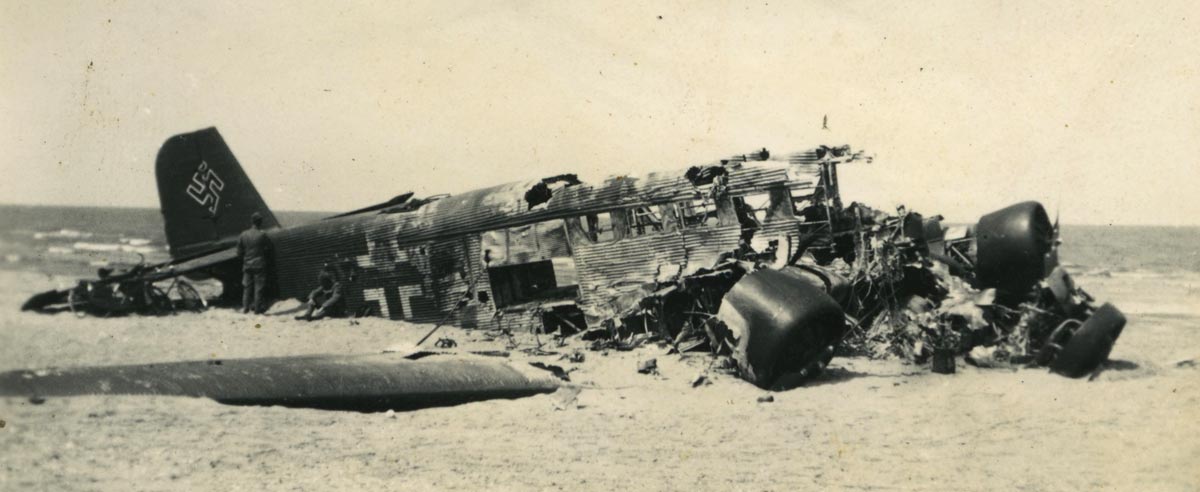 The Netherlands Institute of Military History Collection
The Netherlands Institute of Military History Collection
managed to keep out of
trouble and made her way back to IJmuiden for her rendezvous with the
diamond party. Her three charges made their way back to IJmuiden from
Amsterdam as planned, having also brought with them a bottle of
Napoleon brandy each. The transfer to
HMS
Walpole was not without difficulty, requiring the
unwilling co-operation of a tugboat master, but they arrived back in
Britain early the next morning. Valuations of the diamonds they brought
back have varied from £500,000 to £2.5 million.
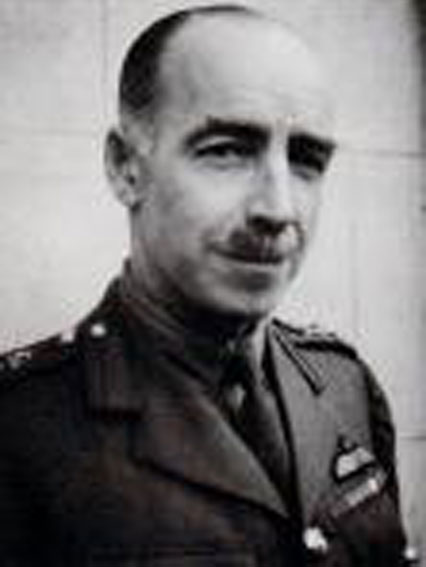
|
|
“On May 12 information reached us that an extremely important collection of industrial diamonds were located in Amsterdam.
Despite the fact that this officer is on the German Black List, he
insisted on going over himself. He proceeded to Amsterdam where he
remained for some 24 hours during which time there was considerable
street fighting and Fifth Column Activity in the town. He brought out
the whole of the industrial diamond stock and this prevented the
Germans from obtaining an extremely important source of industrial
activity.
This action would by itself have won a recommendation for an award but
considered in the light of the certainty of his fate if caught by the
Gestapo, he displayed courage of a very high order.”
|
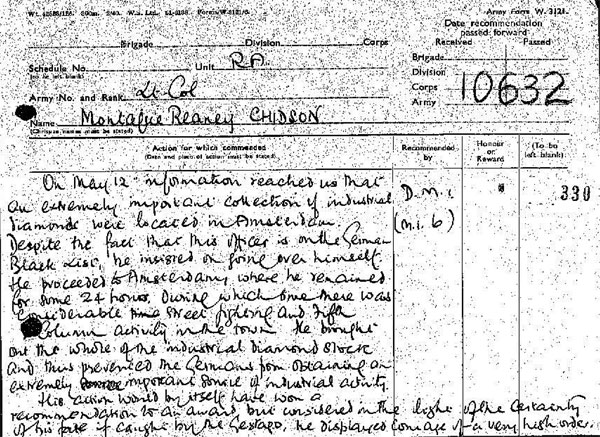 |
The recommendation by DMI (MI6) for the award of the DSO to Lt Col M.R. Chidson was granted and announced in the London Gazette on 20 December 1940
This unsigned note from MI6 is in sharp contrast to the formal Reports of Proceedings with recommendations for awards made by Commanding Officers to the Admiralty
National Archives WO-373-16-272
An exaggerated story?
Walpole’s
mission to bring the industrial diamonds from Amsterdam to Britain
during the Dutch five days war is mainly remembered today because
of a book by the journalist and author, David Esdaile Walker (on right). He was
born in Darjeeling, India, in 1907, the only child of Major General Sir
Ernest Walker, but was educated in Britain.
During the war he combined jobs as foreign correspondent for the
Daily Mirror
and a representative of the Reuters news agency for the Balkans with
work as an agent of MI6 in Switzerland, the Balkans and Greece and this
provided the background for several of his books. His eighth book,
“Adventure in Diamonds”
(Evans Brothers, 1955), is a dramatised account of the mission to
recover the industrial diamonds from Amsterdam. The book was a success
and reached an even larger larger audience when it was filmed by J
Arthur Rank and released as
“Operation Amsterdam” (1959). His novel "
Lunch with a stranger"
(Alan Wingate, 1957) is thought to be partly autobiographical, based on
his own activities as an MI6 agent under the guise of being a foreign
correspondent for the
Daily Mirror.
In Print - Adventure in Diamonds
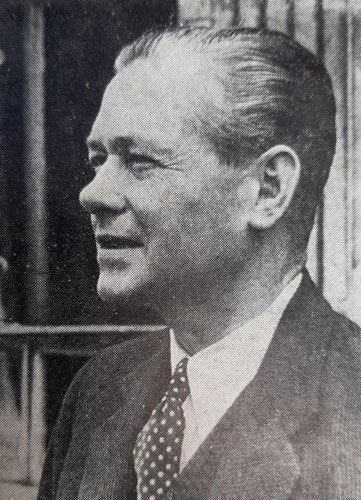
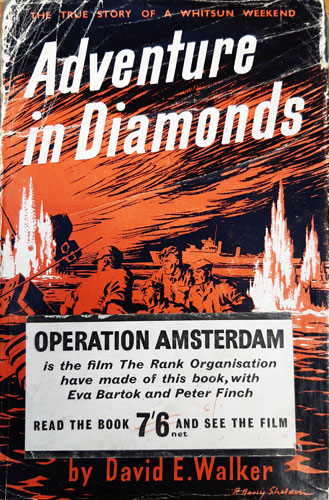
Although long out of print second hand copies can be bought over
the Internet and an e-book version can be read online by clicking on
the link:
https://archive.org/details/adventureindiamo009653mbp/page/n8/mode/2up
Walker’s story centres on three individuals:
Mr Jan Kors Smit, Dutch, a director of J.K. Smit en Zonen in Britain, and grandson of the company’s founder
Mr
“Walter Keyser” [pseudonym for Willem Woltman], Dutch by birth but with
British nationalty and based in Britain, a colleague of Jan Kors Smit
“Major Dillon” [pseudonym for Lt. Col. Chidson], a British soldier with a clear secret service, or similar connection.
Significant roles are also played by:
Mr. Johan J Smit, Dutch, head of J.K. Smit en Zonen in Amsterdam. He is the son of the founder
and father of Jan Kors Smit in London.
Lt Cdr Harold Bowerman, captain of HMS Walpole.
When news reached Britain of the German invasion on Friday 10 May 1940
Jan Kors Smit and “Keyser”, aware of the value Amsterdam’s stocks
of diamonds could be to the German war effort, make their concerns
known to the Board of Trade. They are brought into contact with “Major
Dillon” and the three make their way to Harwich where they board HMS
Walpole,
which has been tasked with taking them to IJmuiden and back. The
destroyer leaves on the night of Sunday 12 May 1940 with all haste. On
the way across the North Sea it nearly collides with two other
destroyers travelling equally fast but towards Britain carrying the
Dutch Crown Princess and her family. At dawn on 13 May 1940, Walpole
arrives at IJmuiden.
The three companions disembark via rowing boat but, almost immediately, the
harbour is attacked by the Luftwaffe, which sinks a civilian liner
carrying refugees. However, our party succeeds in getting ashore only
to be met by scenes of chaos: Dutch soldiers everywhere, dead bodies
piled up, harassed officers and officials, refugees and the
ever-present fear and threat of fifth columnists and German
paratroopers.
The party also meet the mysterious “Anna” who has just seen the parents
of her fiance killed by a German air attack as they were leaving by
trawler. She agrees to take the three to Amsterdam in her car.
In Amsterdam, they meet with one of “Major Dillon’s” contacts and with
Mr Johan J. Smit, head of the J.K. Smit en Zonen diamond company. He
had
already delivered a package of diamonds the previous night to a British
merchant ship and agrees to hand over his remaining diamonds and ask
other diamond merchants if they will hand over their stocks. The
Amsterdam and Antwerp diamond industries were predominantly Jewish
(although the Smit family is not). They were naturally nervous of the
situation and of reprisals if they assisted the British, but at a
subsequent meeting many are reassured and hand over their diamonds to
Jan Kors, “Keyser” and “Major Dillon”.
They return to IJmuiden with the diamonds, avoiding some traitorous
Dutch soldiers on the way with a little help from “Anna’s” boss who is actually a
Dutch Colonel. Despite the chaos and panic in the town they manage to
rejoin
Walpole, but not
without some officious difficulty involving a tug master who refuses to
leave the harbour because he is not qualified for ocean going. This is
resolved after some not so gentle “persuasion” by “Major Dillon”.
Walpole had been sailing up
and down the Dutch coast near Scheveningen and The Hague and had
encountered other destroyers, a merchant ship carrying gold to Britain
and seen evidence of the fighting inland. Having embarked her
passengers from the harbour tug,
Walpole makes it safely back to Britain and the diamonds are handed over to the care of The Diamond Trading Company in London.
After allowing for the exaggerations, sensationalism and the fictional
details required in a novel the book can still be considered a guide to
actual events though not all details are accurate. Walker assures the
reader of the co-operation of the protagonists and some content can
only have come from first-hand accounts by “Keyser” (Willem Woltman),
Lt.Cdr. Bowerman and Johan Smit. “Major Dillon” (Lt.Col. Chidson)
considered himself bound by the Official Secrets Act and declined to
assist. Since Jan Kors Smit died in 1946 his real name could be
used in the book.
On Film - Operation Amsterdam
Walker’s book reads as if written for a screenplay and soon after
publication the film rights were acquired by the Rank Organisation and filmed
at Pinewood Studios and on location in IJmuiden, Schermerhorn and in Amsterdam. It was released in 1959 as
Operation Amsterdam
and starred Peter Finch, Tony Britton, Eva Bartok and, in supporting
roles, Melvyn Hayes and John Le Mesurier. It can be viewed (writing
mid-2020) on YouTube at:
https://www.youtube.com/watch?v=HYnwG73Z9Aw
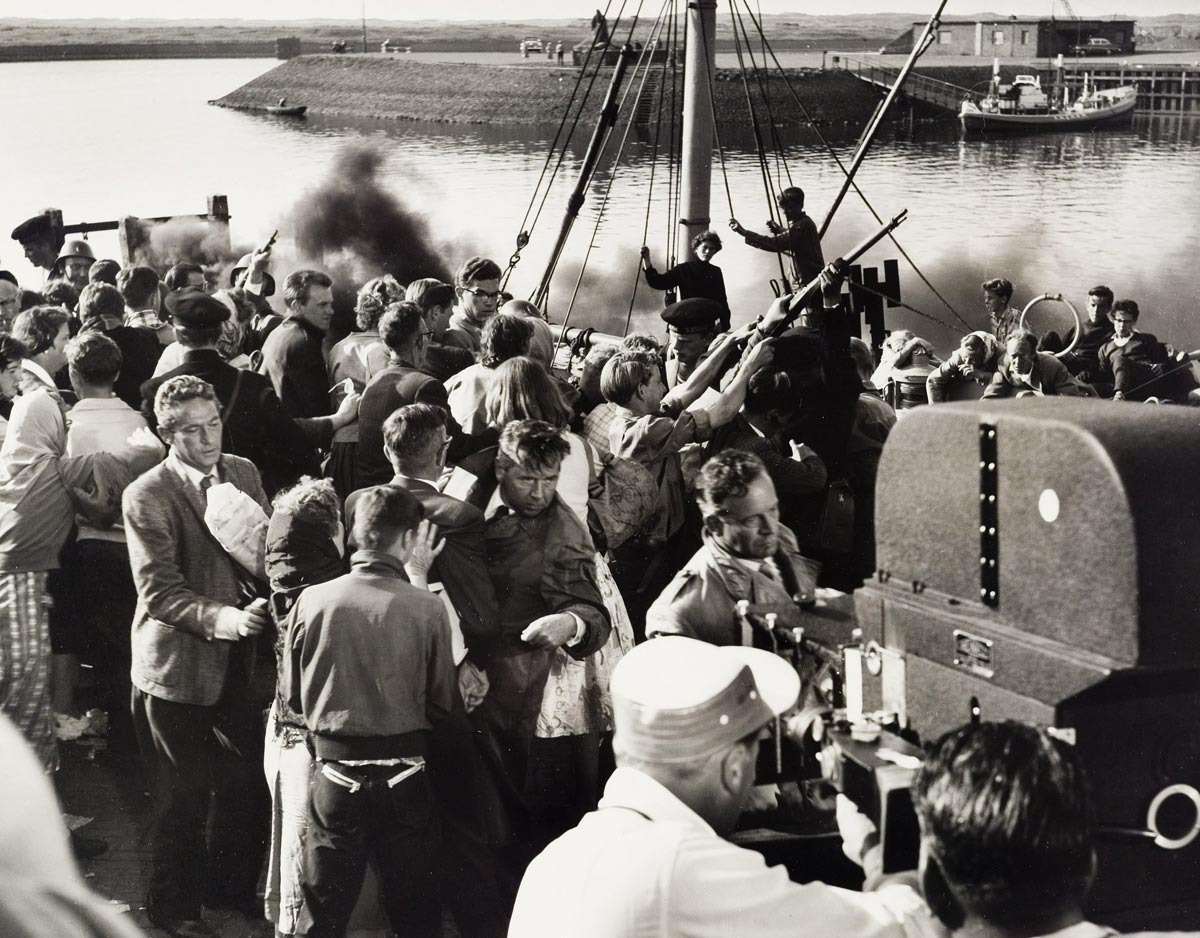 Filming “Operation Amsterdam” in IJmuiden harbour
Filming “Operation Amsterdam” in IJmuiden harbour
Peter Finch (Jan Kors Smit) is left foreground holding a white
package, Alexander Knox (Walter Keyser) is centre foreground
squeezing between two actors, Tony Britton as “Major Dillon” is
in front of the camera
Noord-Hollands Archief (Ref. KNA001005559)
While based on Walker’s book, the second half of the film veers even
further away from his dramatised account. For example, there is a
fire-fight between soldiers, all in Dutch uniform, a fully functioning
resistance cell equipped with German weapons (the Germans only arrived
in Amsterdam on 15 May 1940 and our story takes place on 12-13 May) and
the diamonds are stolen from a bank vault. None of this, of course,
actually happened. Unfortunately, the role that
Walpole plays in the film is marginal.
The film made a substantial contribution to the mythology surrounding the expedition. Its title “
Operation Amsterdam”
is assumed to be the actual name of the mission. Given its hurried,
secret and ad hoc nature, the expedition might not have had a formal
name. There is no evidence for a mission name and it is not mentioned
anywhere in the book “
Adventure in Diamonds”. However, when the book was reprinted in the 1970s, some editions at least were published with the title “
Operation Amsterdam”.
Legend and Myth
HMS Walpole was adopted by the town of Ely in the Fen country of Cambridgeshire
as the result of a successful Warships Week national savings programme
in March 1942 which raised £300,000 for the construction of a new
destroyer. When a civic deputation visited Walpole from Ely in late 1943, the Ely Standard reported on its front page that Walpole had saved the Dutch Crown Jewels. Walpole’s
voyage to Holland on 12 May 1940 had become part of the ship’s
folklore, passed on from shipmate to shipmate and were repeated by the Ely Standard three and a half years later.
Although Walpole’s
return cargo had morphed into the Dutch Crown Jewels this is actually
one of the few references outside of Walker’s book of the ship’s
involvement in those mad May days of 1940. The three individuals
brought back with them industrial diamonds worth perhaps as much as
£2.5 million in current prices and vastly more today. And in June 2020
the Ely Standard published a further article about these latest discoveries.
Another memento of Walpole’s
journey can be found in Gerrards Cross, Buckinghamshire, where Jan Kors
Smit, one of our travellers, lived. He renamed his home - which later
also served as an address for J.K. Smit en Zonen - Walpole House
in honour of the trip he undertook in 1940. After Jan Kors’ death his
brother Johan Jnr lived there. When he died more than fifty years after
these events, he was recorded as living at “Walpole Cottage”, a
different address but still bearing the Walpole name. . Quite clearly,
this ship, her actions, and
this expedition in May 1940 left an indelible impression on the Smit
family.
***************
A similar "mission" took place in
Antwerp, second only to Amsterdam in diamond
cutting, polishing and fashioning. It is much is better documented as
the protagonist wrote it all down, in English, some three years later.
On 11 May 1940 Paul J. Timbal, the CEO of the
Antwerp "diamond bank" and a Belgian Army reservist, left Antwerp with
100 million Belgian Francs (around 67 million Euros) of diamonds for
Paris. He was accompanied by his wife and two daughters, and arrived
two days later. Concerned about
the safety of Paris, he moved on to Royan at the mouth of the Gironde
near Bordeaux, but with the fall of France imminent decided to move on
again to Britain.
Operation Ariel was the code name for the evacuation of troops and civilians from the western ports of France between 15 - 25 June 1940. By this time, MI6 was aware of what Timball was doing and sent the steamship Broompark to bring him to Falmouth. Lord "Wild Jack" Suffolk
organised the evacuation of Timbal and French nuclear scientist with
heavy water. Three years later Timball wrote a 353 page book, published
in English in 2014 by the Belgian Royal Commission on History with the
title, "Why the Belgian Diamonds Never Fell Into Enemy Hands, May 10, 1940 - June 23, 1940" (Commission
royale d'histoire, 2014). The Bartlett Maritime Research Centre in the
National Maritime Museum Cornwall, Falmouth, has published an online
account of the Broompark's arrival at Falmouth with the diamonds and heavy water.
If you can provide further details of the diamond mission or have any queries about it contact Darron Wadey by e-mail.
Darron is a British national
resident in the Netherlands. He is a member of a number of (military)
historical associations and societies.
His research concentrates upon British actions during the invasion of the Netherlands in May 1940.

 HMS WALPOLE
HMS WALPOLE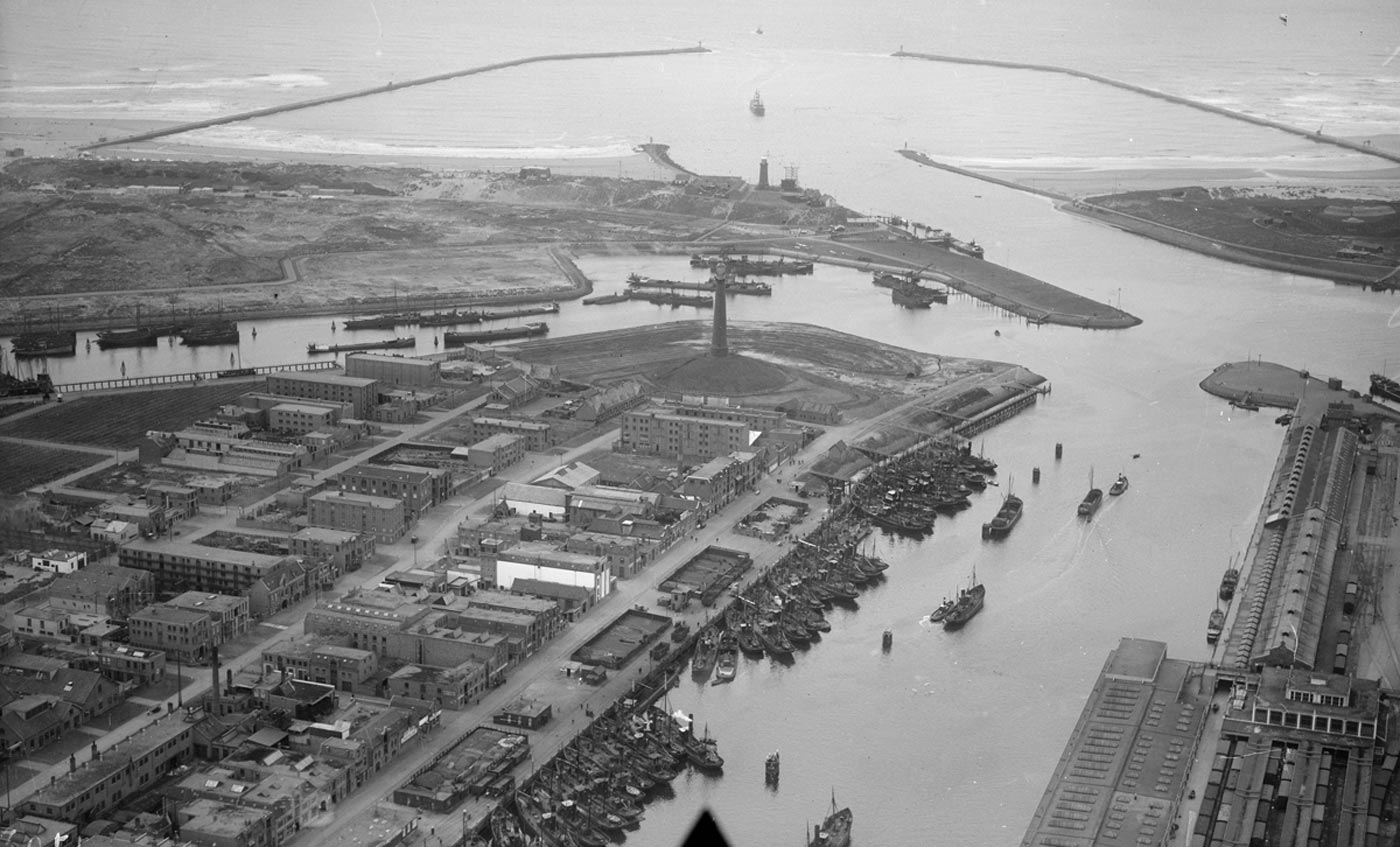
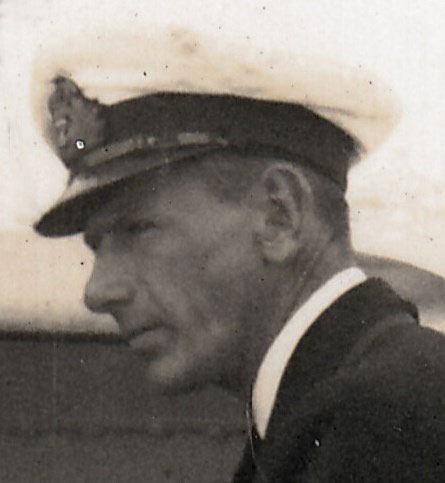
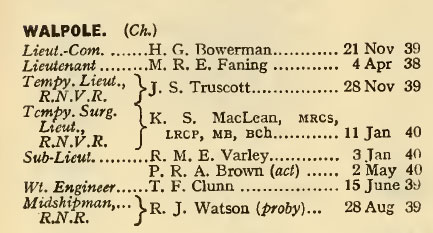
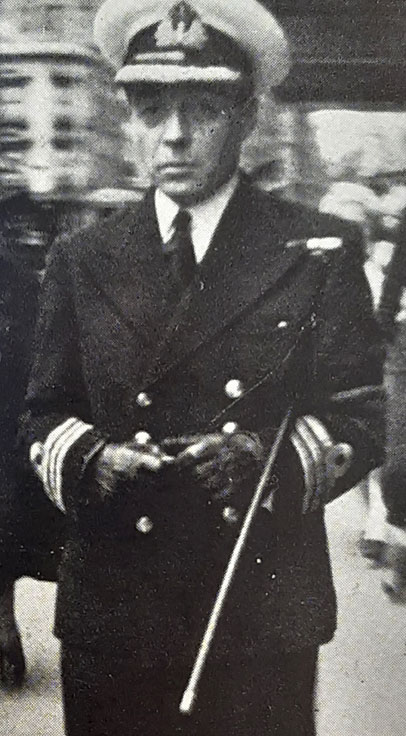
 The Netherlands was neutral in the First World War. Belgium, Luxembourg
and Switzerland were neutral by treaty but the Netherlands was neutral
by choice. Although the Dutch was not one of the belligerents it was
one of the first to mobilise and sent around 200,000 troop to defend
the Nineteenth century Waterline (Waterlinie) and Amsterdam Fortifications (Stelling van Amsterdam).
The Dutch managed to maintain its neutrality but had to cope with the
consequences of the war: refugees, food shortages and the need to
intern soldiers or sailors - from both sides - who happened to end up
in Dutch territory.
The Netherlands was neutral in the First World War. Belgium, Luxembourg
and Switzerland were neutral by treaty but the Netherlands was neutral
by choice. Although the Dutch was not one of the belligerents it was
one of the first to mobilise and sent around 200,000 troop to defend
the Nineteenth century Waterline (Waterlinie) and Amsterdam Fortifications (Stelling van Amsterdam).
The Dutch managed to maintain its neutrality but had to cope with the
consequences of the war: refugees, food shortages and the need to
intern soldiers or sailors - from both sides - who happened to end up
in Dutch territory. 

 The three passengers on HMS Walpolewere
tasked with recovering as many industrial diamonds from Amsterdam
as they could. Two of the party were employees of J.K. Smit en Zonen,
at that time one of the largest diamond companies in the world. The other was a
member of the British secret service. J.K. Smit en Zonen was an
international company with an office in London. Two of its Dutch
representatives in Britain, Jan Kors Smit and Willem Woltman, joined
HMS Walpole.
Jan Kors Smit (on left) was the grandson of the company’s founder, Jan
Kors, and son of the current head, Mr. Johan J. Smit (on right) in
Amsterdam. Both photographs are courtesy of JK Smit Diamond Tools.
The three passengers on HMS Walpolewere
tasked with recovering as many industrial diamonds from Amsterdam
as they could. Two of the party were employees of J.K. Smit en Zonen,
at that time one of the largest diamond companies in the world. The other was a
member of the British secret service. J.K. Smit en Zonen was an
international company with an office in London. Two of its Dutch
representatives in Britain, Jan Kors Smit and Willem Woltman, joined
HMS Walpole.
Jan Kors Smit (on left) was the grandson of the company’s founder, Jan
Kors, and son of the current head, Mr. Johan J. Smit (on right) in
Amsterdam. Both photographs are courtesy of JK Smit Diamond Tools.



 Although long out of print second hand copies can be bought over
the Internet and an e-book version can be read online by clicking on
the link: https://archive.org/details/adventureindiamo009653mbp/page/n8/mode/2up
Although long out of print second hand copies can be bought over
the Internet and an e-book version can be read online by clicking on
the link: https://archive.org/details/adventureindiamo009653mbp/page/n8/mode/2up